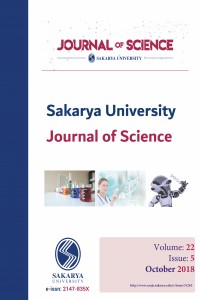Abstract
References
- [1] Nurcan Uludağ, “Bulanık Optimizasyon ve Doğrusal Hedef Programlama Yaklaşımları ile Otobüs Hatlarının Modellenmesi” Doktora Tezi, Pamukkalae Üniversitesi Denizli, pp. 1-12, Mayıs 2010.
- [2] Dhananjay B. Nalawade, Ajay D. Nagne, Rajesh K. Dhumal, K. V. Kale, “Multilevel Framework for Optimizing Bus Stop” International Journal of Research in Engineering and Technology (IJRET), volume: 5, issue: 05, pp. 298–304, 2016.
- [3] Rodrigue, J.-P., et al. “The Geography of transport systems” (Second ed.). New York: Routledge, 2009.
- [4] Vuchic, V. R. “Urban Public Transportation Systems.” Unpublished Glossary of Terms List of Abbreviations. University of Pennsylvania, 2002.
- [5] R.G. Farewell and E, Marx., “Planning, implementation and evaluation of OmnRide demad-driven Transit Operations: Feeder and flex-route services” Transportation Research Record 1557, pp. 1-9, 1996.
- [6] M.FLetterman, “Multi –Realisation of Nonlinear Systems”, University of Pretoria, Thesis, 2008.
- [7] Chien, S and Schonfeld, P., “Optimisation of Grid Transit System in Heterogeneous Urban Environment”, Journal of Transportation Engineering, 1997 123(1), 28-35.
- [8] Jahani, M., Hashemi, S.M., Ghatee, M and Jahanshahi, M., (2013) “A Novel Model for Bus Stop Location Appropriate for Public Transit Network Design: The Case of Central Business Districts (CBD) of Tehran”, International Journal of Smart Electrical Engineering, Vol.2 No.3, pp: 133-141, 2013.
- [9] Wei Xuebin, “Optimizing Bus Stop Locations in Wuhan, China” International Institute For Geo-Information Science And Earth Observation Enschede, The Netherlands, February, 2010.
- [10] Transit Cooperative Research Program, “TCRP Report 19, Guidelines for the Location and Design of Bus Stops,” National Academy Press; pp. 18 Washington, D.C., 1996.
Abstract
In today's
world, the needs for transportation have increased and the existing solutions
have become insufficient in response to the demand especially with the increase
of urban life and the widespread urbanisation. For this reason, local authorities aim to
improve urban public transportation services, one of the effective in-city
transportation solutions, in order to solve the current needs of transport and
reduce or regulate the current traffic intensity.
In this study, geographical
information system (GIS) was used to analyse the relationship between the bus
routes and related stops being offered by Sakarya Metropolitan Municipality
(SBB) public transportation service along with the population living in the
region to evaluate the level of available current service to the population in
each region. An alternative optimisation for the locations of bus stops was
presented through a proposed model by comparing the results obtained from the
existing positions.
References
- [1] Nurcan Uludağ, “Bulanık Optimizasyon ve Doğrusal Hedef Programlama Yaklaşımları ile Otobüs Hatlarının Modellenmesi” Doktora Tezi, Pamukkalae Üniversitesi Denizli, pp. 1-12, Mayıs 2010.
- [2] Dhananjay B. Nalawade, Ajay D. Nagne, Rajesh K. Dhumal, K. V. Kale, “Multilevel Framework for Optimizing Bus Stop” International Journal of Research in Engineering and Technology (IJRET), volume: 5, issue: 05, pp. 298–304, 2016.
- [3] Rodrigue, J.-P., et al. “The Geography of transport systems” (Second ed.). New York: Routledge, 2009.
- [4] Vuchic, V. R. “Urban Public Transportation Systems.” Unpublished Glossary of Terms List of Abbreviations. University of Pennsylvania, 2002.
- [5] R.G. Farewell and E, Marx., “Planning, implementation and evaluation of OmnRide demad-driven Transit Operations: Feeder and flex-route services” Transportation Research Record 1557, pp. 1-9, 1996.
- [6] M.FLetterman, “Multi –Realisation of Nonlinear Systems”, University of Pretoria, Thesis, 2008.
- [7] Chien, S and Schonfeld, P., “Optimisation of Grid Transit System in Heterogeneous Urban Environment”, Journal of Transportation Engineering, 1997 123(1), 28-35.
- [8] Jahani, M., Hashemi, S.M., Ghatee, M and Jahanshahi, M., (2013) “A Novel Model for Bus Stop Location Appropriate for Public Transit Network Design: The Case of Central Business Districts (CBD) of Tehran”, International Journal of Smart Electrical Engineering, Vol.2 No.3, pp: 133-141, 2013.
- [9] Wei Xuebin, “Optimizing Bus Stop Locations in Wuhan, China” International Institute For Geo-Information Science And Earth Observation Enschede, The Netherlands, February, 2010.
- [10] Transit Cooperative Research Program, “TCRP Report 19, Guidelines for the Location and Design of Bus Stops,” National Academy Press; pp. 18 Washington, D.C., 1996.
Details
| Primary Language | English |
|---|---|
| Subjects | Civil Engineering |
| Journal Section | Research Articles |
| Authors | |
| Publication Date | October 1, 2018 |
| Submission Date | February 14, 2018 |
| Acceptance Date | March 12, 2018 |
| Published in Issue | Year 2018 Volume: 22 Issue: 5 |
Cite
Cited By
Modelling future urban scenarios of land suitability: a case study of Jihlava city
International Journal of Digital Earth
https://doi.org/10.1080/17538947.2024.2433613
This work is licensed under a Creative Commons Attribution-NonCommercial 4.0 International License.


